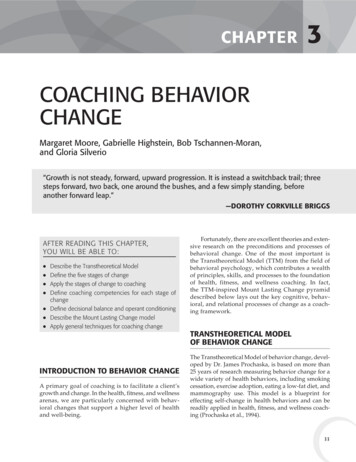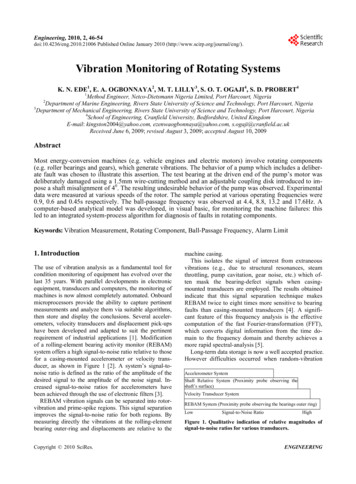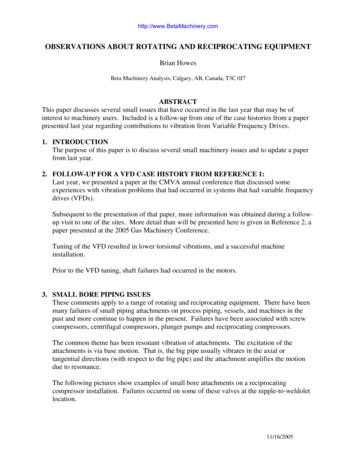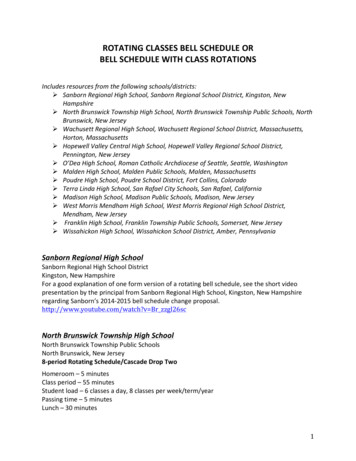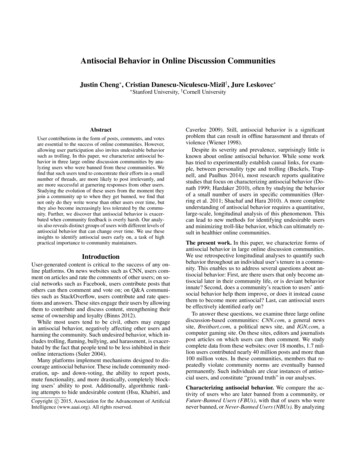
Transcription
Rotating Online Behavior Change InterventionsIncreases Effectiveness But Also Increases AttritionGEZA KOVACS, Department of Computer Science, Stanford University, USAZHENGXUAN WU, Department of Computer Science, Stanford University, USAMICHAEL S. BERNSTEIN, Department of Computer Science, Stanford University, USABehavior change systems help people manage their time online. These systems typically consist of a singlestatic intervention, such as a timer or site blocker, to persuade users to behave in ways consistent with theirstated goals. However, static interventions decline in effectiveness over time as users begin to ignore them. Inthis paper, we compare the effectiveness of static interventions to a rotation strategy, where users experiencedifferent interventions over time. We built and deployed a browser extension called HabitLab, which featuresmany interventions that the user can enable across social media and other web sites to control their timespent browsing. We ran three in-the-wild field experiments on HabitLab to compare static interventions torotated interventions. Rotating between interventions increased effectiveness as measured by time on site, butalso increased attrition: more users uninstalled HabitLab. To minimize attrition, we introduced a just-in-timeinformation design about rotation. This design reduced attrition rates by half. With this research, we suggestthat interaction design, paired with rotation of behavior change interventions, can help users gain control oftheir online habits.CCS Concepts: Human-centered computing Empirical studies in collaborative and social computing; Collaborative and social computing systems and tools;Additional Key Words and Phrases: Social computing; behavior changeACM Reference Format:Geza Kovacs, Zhengxuan Wu, and Michael S. Bernstein. 2018. Rotating Online Behavior Change InterventionsIncreases Effectiveness But Also Increases Attrition. Proc. ACM Hum.-Comput. Interact. 2, CSCW, Article 95(November 2018), 25 pages. https://doi.org/10.1145/32743641INTRODUCTIONWe wish to spend our time more productively, but we sink hours into social media; we wish tolearn new languages, but we get too busy to practice; we wish to be more healthy, but we do notmaintain our exercise routines [24]. Inspired by situations like these, behavior change systems helppeople build new habits and retain them [25, 41, 53, 56]. Behavior change systems draw on theoriesof persuasion and influence [22, 40] to introduce interventions: interaction designs that variouslyinform, nudge, and encourage people to engage in behaviors more in line with their goals.Behavior change systems today suffer from declining effectiveness as novelty wears off overtime. Typically, behavior change systems utilize a static design, which never changes. For example,to manage social media browsing time, the three popular options are to block tempting sites [98],Authors’ addresses: Geza Kovacs, Department of Computer Science, Stanford University, 353 Serra Mall, Stanford, CA,94305, USA, geza@cs.stanford.edu; Zhengxuan Wu, Department of Computer Science, Stanford University, 353 Serra Mall,Stanford, CA, 94305, USA, wuzhengx@stanford.edu; Michael S. Bernstein, Department of Computer Science, StanfordUniversity, 353 Serra Mall, Stanford, CA, 94305, USA, msb@cs.stanford.edu.Permission to make digital or hard copies of all or part of this work for personal or classroom use is granted without feeprovided that copies are not made or distributed for profit or commercial advantage and that copies bear this notice and thefull citation on the first page. Copyrights for components of this work owned by others than the author(s) must be honored.Abstracting with credit is permitted. To copy otherwise, or republish, to post on servers or to redistribute to lists, requiresprior specific permission and/or a fee. Request permissions from permissions@acm.org. 2018 Copyright held by the owner/author(s). Publication rights licensed to the Association for Computing Machinery.2573-0142/2018/11-ART95 15.00https://doi.org/10.1145/3274364Proceedings of the ACM on Human-Computer Interaction, Vol. 2, No. CSCW, Article 95. Publication date: November 2018.95
95:2G. Kovacs et al.use a work timer [39], and audit time spent [54, 84]. However, static interventions suffer from highattrition and abandonment rates [23, 36], and interventions decline in effectiveness over time [59].Habituation eventually drives users to stop paying attention to, or avoid, static interventions—aneffect often seen on the web as banner blindness [14]. The end result is that many behavior changesystems are tuned out by users, and are unsuccessful at their goals.If static interventions are tuned out, rotation might provide a remedy. Much like a human coachor tutor rotates between different approaches over time, rotation might maintain attention in waysthat static interventions cannot. Online behavior change tools could apply similar techniques, forexample injecting a visible stopwatch timer into the page on one visit to Facebook, and hidingcomments on the next visit. Techniques that personalize interventions via multi-armed banditsshow positive treatment effects, suggesting that the approach may hold promise, but this existingwork cannot separate the effects of personalization from the effects of rotation [60, 76, 82]. Becauserotated interventions continually change the user interface, however, they may frustrate users byviolating consistency and a sense of user control, leading to lower effectiveness or higher attrition.This paper takes up the question: are static or rotated interventions more effective for behaviorchange? Is it possible to understand the effects of rotation in order to design more effective behaviorchange systems? We focus specifically on helping users who want to manage their time on socialmedia websites such as Facebook, YouTube, Reddit, and Twitter. We perform a series of fieldexperiments with people who sought out and installed a browser extension that we developed foronline behavior change.Our platform, HabitLab (https://habitlab.stanford.edu) is a Chrome extension that features anumber of online productivity interventions to help users reduce their time spent on sites such asFacebook. We released HabitLab publicly on the Chrome web store, where it has attracted over8,000 daily active users. This user base allows us to observe real-world usage and attrition patternsover time.We ran three in-the-wild studies on users who newly installed HabitLab. In Study 1, we comparedstatic interventions to rotation. We measured effectiveness through time on the user’s targeted site,and we measured attrition by tracking when users stopped using the extension. Results indicatethat rotation is a double-edged sword. Rotating interventions reduced time spent on sites by 34%per day, but at the cost of nearly doubling attrition levels.Study 2 replicates the first experiment over a longer period of seventy days, and additionallytests whether the number of interventions included in the rotation impacts attrition. The resultssuccessfully replicated the original results over a longer 70-day period, and suggested that thelarger the set of interventions, the higher the probability of attrition.To investigate the underlying causes of attrition and mitigate the effects of rotation on attrition,we analyzed user feedback and developed a pair of interface techniques to improve the userexperience in the presence of rotation, which we deployed in Study 3. The first technique isinformational, aiding people’s mental models by reminding them that the system may show adifferent intervention on each visit. The second technique focuses on user control, providing thesame information as well as a just-in-time mechanism for people to opt out of each new interventionas they see it. Results indicated that these interventions reduced attrition by over half, so that 80%of new users were still using the system actively after a week.In sum, this paper contributes the first comparison of static and rotation intervention strategiesin behavior change, a living laboratory system that allows us to deploy this investigation and otherfield experiments, and interaction design strategies that can help offset increased attrition due torotation. Its results suggest that people may be more able to control their social media usage moreeffectively than using today’s common techniques such as site blockers. The rest of the paper isorganized as follows: we first review studies of behavior change to develop our research questionProceedings of the ACM on Human-Computer Interaction, Vol. 2, No. CSCW, Article 95. Publication date: November 2018.
Rotating Online Behavior Change Interventions95:3and hypotheses; we then describe our studies and results; we close with reflections and futuredesign directions.2BEHAVIOR CHANGE AND MOTIVATIONThe field of persuasive technology studies how technology can be used to influence behavior [40].Persuasive technology systems have been successful in promoting behaviors such as sustainableresource usage [41], fitness [25], sleep [18, 53], healthy eating [32, 74], stress management [2, 90],smoking cessation [75], and productivity [56, 103]. One common framework of behavior change isthe B MAT model [40], which states that desired behaviors result when motivation, ability, and atrigger (a call to action) are all present. Another framework of habit change is the habit loop [35],which tells us that designs can build habits via a repeated process of displaying a trigger, havingthe user take an action, providing a reward, and having the user invest in the system.A number of taxonomies characterize the design space of interventions, both general [1, 31,66, 67] and domain-specific [44, 102]. Michie’s behavior change taxonomy lists 93 techniques forbehavior change, clustered according to the cognitive phenomenon they target [66]. Systems haveinvestigated effects of these techniques individually, such as using “cheating” to support lapsemanagement [4], using different framings to present results [56], or setting goals and plans [5].People use a variety of sociotechnical systems to support behavior change, including forums [17,37], social sharing [21, 57, 77, 78], personal informatics [20, 61], and self-experimentation [52].People use behavior change forums to gain social support [47] – meeting social needs such asapproval and esteem [50]. They do so by providing users with information and advice [47], andestablishing norms [17]. They also facilitate social comparisons [28] which influence behaviors, associal comparison theory states that users seek to bring their behaviors in line with norms [38].Communities also help users find others with similar experiences [48] who can help them throughthe process of recovering and adapting to changes [71]. Social sharing [78, 85] works by helpingusers receive support through social interactions, and encouraging accountability [33]. Personal informatics support behavior change through stages of preparation, collection, integration, reflection,and action [61]. The theory of lived informatics [34] adds additional stages where users choosetracking tools, and alternate between lapsing and resuming their tracking behaviors. HabitLabcombines personal informatics and self-experimentation to support behavior change. Our studydraws on lived informatics by evaluating whether rotating interventions is an effective strategy tocombat lapses such as ignoring interventions or uninstalling.One major topic inspiring our work is users’ desires to curb or control their time spent onsocial media sites. People pressure themselves to, and often do, make efforts to reduce their timespent on social media sites such as Facebook and Twitter [91, 94]. Yet this is difficult becauseusers turn to social media to address their need to belong, the need for self-presentation, the needfor self-esteem [69], the need for entertainment and gratification [80], and self-affirmation [97].Whether social media use improves well-being is a complex question depending on the natureof the engagement [55, 62, 65, 68, 88, 95, 100], but thanks to instant gratification and sites’ use ofgamification [19, 49, 104] and behavior design techniques [35, 40] to drive engagement, users keepcoming back to the point that some consider it an addiction [10, 87, 96, 99].Much previous work has focused on gamification as an approach to design behavior changesystems [30]. Gamification has been shown to have positive effects on engagement and outcomesin behavior-change contexts such as promoting healthy habits [26, 64] and improving educationalengagement [8, 9], though effectiveness varies depending on the context and design [43].Attrition is a major challenge in behavior change systems. Attrition [36], also known as dropout,occurs when participants stop participating, leave, or uninstall the system. Persuasive systems builtfor weight control and therapy have shown substantial attrition rates in longitudinal studies [15, 76],Proceedings of the ACM on Human-Computer Interaction, Vol. 2, No. CSCW, Article 95. Publication date: November 2018.
95:4G. Kovacs et al.and prior work in CSCW has sought to help reduce attrition rates through techniques drawn fromdieting and addiction research [4].A recent trend in behavior change systems has been the concept of personalizing interventions.Such systems explore several possible strategies using techniques such as multi-armed banditsto find the intervention that is most effective for the user [76, 81]. For example, PopTherapydemonstrated personalized messaging could be found through such techniques [76]. Likewise,HeartSteps conducted tens or hundreds of micro-randomized trials on users [29]. When multiarmed bandits are just beginning to get feedback from a user, they will try out several differentinterventions to see what works. This exploration has the effect of rotation, but the amount ofr
95 Rotating Online Behavior Change Interventions Increases Effectiveness But Also Increases Attrition GEZA KOVACS, Department of Computer Science, Stanford University, USA ZHENGXUAN WU, Department of Computer Science, Stanford University, USA MICHAEL S. BERNSTEIN, Department of Computer Science, Stanford University, USA Behavior change systems help people manage their time online.
